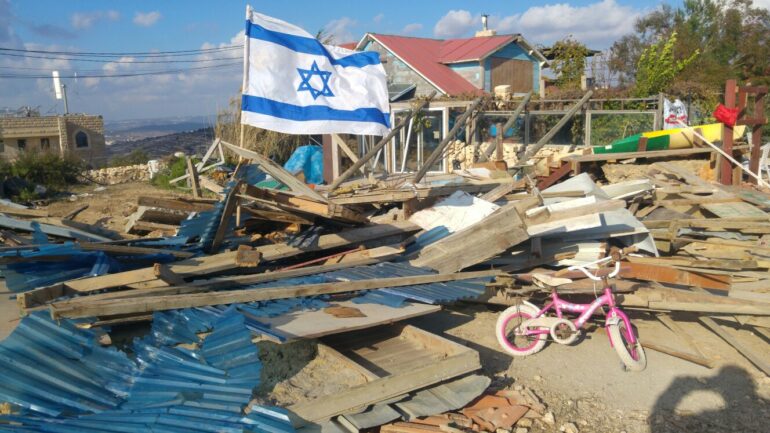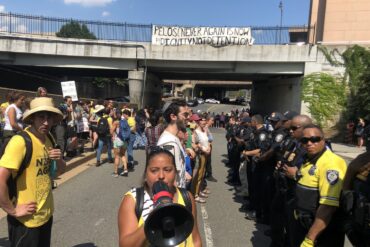Israeli security forces destroyed 15 homes this week in the town of Elazar’s Netiv HaAvot neighborhood. Elazar is one of the communities comprising the West Bank’s Gush Etzion region just south of Jerusalem.
Security forces destroyed 10 homes on Tuesday and five more Thursday morning. But what took place at Netiv HaAvot was noticeably different from previous demolitions of West Bank Jewish communities. While several journalists were on hand for the forced expulsion and destruction, reports on the event weren’t featured prominently in the week’s news cycle.
What stood out to many journalists was the weak resistance demonstrated by residents and their supporters, making the story far less dramatic than the February 2017 demolition of Amona, just outside Ofra in northern Judea. In terms of numbers, the roughly 1,000 people who showed up to resist the razing of the Netiv HaAvot homes were approximately half the amount that crammed into Amona caravans prior to that community’s destruction.
The Netiv HaAvot expulsions also took place without the violent standoffs of Amona, although angry protests did erupt elsewhere throughout the West Bank Tuesday night.
Gush Etzion community leaders present at Netiv HaAvot on Tuesday attributed the more mild resistance to the nature of the population involved. Unlike other parts of the West Bank – most notably Hebron, northern Judea and the Samaria region – Gush Etzion communities are typically viewed as more bourgeois in nature, with most Jewish residents living in affluent gated communities and feeling themselves fully supported by the Israeli state.
“In Amona, it was more militant, with residents wanting to put up a fight,” said Yesha council director-general Shiloh Adler, adding that the majority of those who came to Netiv HaAvot on Tuesday were from surrounding communities in Gush Etzion, “which is in the heart of the Israeli consensus.”
Gush Etzion Regional Council Chairman Shlomo Ne’eman said that many of his residents “simply don’t connect” to protests like the kind seen at other demolitions.
15-year-old Eitan Kalman, who was among the dozens of young men sitting on the living room floor inside the last Netiv HaAvot home to be demolished, said that protesting to him meant “being picked up, dragged out and then heading back home to Alon Shvut.”
“This isn’t Amona. Nobody here really wants to leave in handcuffs.”
The low turnout and broader Israeli public’s lack of interest in the Supreme Court’s demolition order against the Elazar neighborhood might have had something to do with the how the issue was framed by Netiv HaAvot residents themselves.
On one hand, local families referred to themselves as “normative people” — Gush Etzion residents “living in the heart of the Israeli consensus.” But at the same time, public relations videos released in the months leading up to the demolition referred to their living there as an “ideological” decision made on behalf of the land of Israel.
The desire to simultaneously appear as both ideologically committed to the Jewish struggle for the homeland and “normal” to the more westernized Israeli ruling class might have cost the community support from both sides of the political map. Gush Etzion residents will ultimately need to choose between the struggle for the land of Israel and being accepted as part of the Israeli mainstream.
Attempting to have their cake and eat it too in this regard has privileged Gushnikim far more than other West Bank Jews, who have trouble relating to the bourgeois colonialist lifestyle and “settler” mentality that characterizes Gush Etzion.
While Jews living in the northern West Bank are typically among the more hardcore activists one would expect to see on the rooftops of homes slated for demolition, the geographical distance from Elazar was not the only reason many didn’t show up this week.
One activist living in a village near the northern West Bank community of Yitzhar laughed when asked whether or not he planned to resist the demolitions at Elazar.
“You call that resistance? It’s a bunch of Ashkenazim singing ‘koombaya,’” he said, mocking the Gush Etzion residents for living “comfortable lifestyles in their massive villas.”
Public figures supportive of Jewish communities in the West Bank, however, arrived in Netiv HaAvot Thursday to encourage the Jews who lost their homes.
Member of Knesset Motti Yogev (Bayit Yehudi) visited the expelled families Thursday morning and watched as the final houses were demolished.
“These are difficult sights to see,” Yogev told journalists. “The unnecessary destruction of homes in Netiv HaAvot in the land of Israel, the great pain of the families, the great pain of the Jewish people and the great pain of the Israel Defense Forces, which was forced to deal with this. This is all the responsibility of the Supreme Court, which again harmed both the fabric of Israeli life and our presence in the land of Israel.”
“I have no doubt that we will know how to restrain the Supreme Court and put it in its place,” he added. “We will also continue to build the Netiv HaAvot neighborhood and build hundreds of homes here, as well as in the entire land of Israel.”
“The sights make one shudder, and the thought of why this is happening makes one shudder even more,” said MK Rabbi Yehuda Glick (Likud).
“It brings me back to the sights of Gush Katif, for which today we are paying the price. It’s just awful. It’s done just because of the evil of organizations that decided to talk for Palestinians, as it were, even though no Palestinian is going to get any benefit from this. There are no words.”





